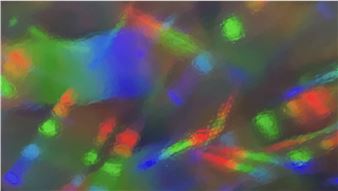Jan Henderikse & ZERO
In 1960 Jan Henderikse signs the Oberkasseler BrГјcke in his new hometown of DГјsseldorf. This act marks an artistic departure in his life. He had left the Netherlands and his native city of Delft the previous year. He had also left painting permanently behind him. With his great friend and mentor Jan Schoonhoven вҖ“ вҖҳthe old masterвҖҷ, as Henderikse continues to call him to this day вҖ“ he founds the NUL group together with Armando and Henk Peeters. herman de vries also joins them. Interesting developments are afoot in DГјsseldorf. ZERO is founded there by Heinz Mack and Otto Piene and Uecker joins them. There are a couple of avant-garde galleries, Gunar and Schmela, where the new art is exhibited.
ZERO in Germany, NUL in the Netherlands, AZIMUTH in Italy and NOUVEAU RГүALISME in France: movements with parallel ways of thinking and objectives and with mutual, friendly connections. What they have in common is the rejection of the art of painting and of colour in general. It has to be monochrome and preferably white. Further important characteristics are seriality (mass-production-style manufacture of works of art) and repetition (repeating the same pattern).
For Henderikse art is not so much an object but rather an idea. He starts with objects that already exist and that were not produced as art. Corks, license plates, coins, odds and ends: Henderikse assembles them into reliefs. He is the вҖҳready-madesвҖҷ man. Creating art by not making it yourself is actually his ultimate challenge. Sculptures with neon designs are something he has often made, or had made. In Antwerp, six months ago, he wrote the words вҖҳnulвҖҷ and вҖҳZEROвҖҷ a number of times on a sheet of paper. A glassblower and neon technician will execute these in neon. Jan is enthusiastic about the blocks, at the same time transformers, on which the neon letters will have to be mounted. He has already signed and numbered them, two series of six. The fact that some of it has yet to be made is of no importance. The signature precedes the artwork itself.
After all, for Jan Henderikse art is more an idea rather than an object.

Recommended for you
In 1960 Jan Henderikse signs the Oberkasseler BrГјcke in his new hometown of DГјsseldorf. This act marks an artistic departure in his life. He had left the Netherlands and his native city of Delft the previous year. He had also left painting permanently behind him. With his great friend and mentor Jan Schoonhoven вҖ“ вҖҳthe old masterвҖҷ, as Henderikse continues to call him to this day вҖ“ he founds the NUL group together with Armando and Henk Peeters. herman de vries also joins them. Interesting developments are afoot in DГјsseldorf. ZERO is founded there by Heinz Mack and Otto Piene and Uecker joins them. There are a couple of avant-garde galleries, Gunar and Schmela, where the new art is exhibited.
ZERO in Germany, NUL in the Netherlands, AZIMUTH in Italy and NOUVEAU RГүALISME in France: movements with parallel ways of thinking and objectives and with mutual, friendly connections. What they have in common is the rejection of the art of painting and of colour in general. It has to be monochrome and preferably white. Further important characteristics are seriality (mass-production-style manufacture of works of art) and repetition (repeating the same pattern).
For Henderikse art is not so much an object but rather an idea. He starts with objects that already exist and that were not produced as art. Corks, license plates, coins, odds and ends: Henderikse assembles them into reliefs. He is the вҖҳready-madesвҖҷ man. Creating art by not making it yourself is actually his ultimate challenge. Sculptures with neon designs are something he has often made, or had made. In Antwerp, six months ago, he wrote the words вҖҳnulвҖҷ and вҖҳZEROвҖҷ a number of times on a sheet of paper. A glassblower and neon technician will execute these in neon. Jan is enthusiastic about the blocks, at the same time transformers, on which the neon letters will have to be mounted. He has already signed and numbered them, two series of six. The fact that some of it has yet to be made is of no importance. The signature precedes the artwork itself.
After all, for Jan Henderikse art is more an idea rather than an object.
















